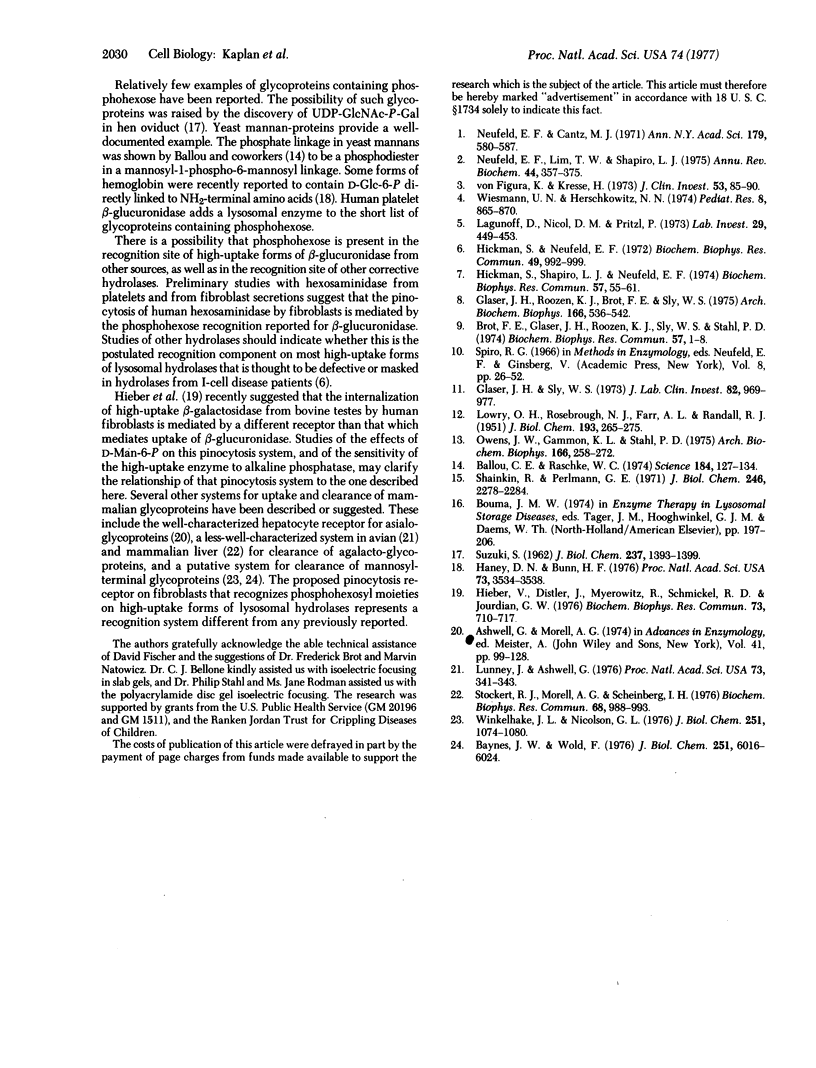Abstract
Human beta-glucuronidase (beta-D-glucuronide glucuronosohydrolase, EC 3.2.1.31), like many other glycoprotein lysosomal hydrolases, is specifically taken up from the culture medium by human fibroblasts. Prior work has indicated that the enzyme exhibits charge heterogeneity and that "high-uptake" forms, i.e., those rapidly internalized by human fibroblasts, are more acidic than slowly internalized forms. Here we present two lines of evidence that the acidic group required for the high-uptake property of certain forms of the enzyme is a phosphate on, or in proximity to, a D-mannose-type carbohydrate. The first line of evidence was obtained from analysis of inhibition of enzyme pinocytosis by yeast mannans, phosphorylated sugars, and sugars. Mannans that contained phosphate were more potent inhibitors than those that did not contain phosphate. D-Mannose 6-phosphate was a more potent inhibitor than either D-mannose 1 phosphate or 2-deoxy-D-glucose 6-phosphate. D-Mannose and certain related sugars were weak pinocytosis inhibitors, while 2- and 4-epimers of mannose were noninhibitory. Competitive inhibition was demonstrated and the apparent Kis estimated for the following compounds: Saccharomyces cerevisiae mannan from mutant X2180-mnnl, 3 X 10(-6) M; mannan from wild-type S. cerebisiae, 3 X 10(-5) M; D-mannose 6-phosphate, 6 X 10(-5) M; L-fucose, 4 X 10(-2) M; and D-mannose, 6 X 10(-2) M. The second line of evidence comes from the observation that alkaline phosphatase [orthophosphoric-monoester phosphohydrolase (alkaline optimum), EC 3.1.3.1] treatment of human platelet beta-glucuronidase abolished its "high-uptake" activity, without diminishing its catalytic activity, and converted some forms of the heterogeneous enzyme to less acidic forms.
Full text
PDF




Images in this article
Selected References
These references are in PubMed. This may not be the complete list of references from this article.
- Ballou C. E., Raschke W. C. Polymorphism of the somatic antigen of yeast. Science. 1974 Apr 12;184(4133):127–134. doi: 10.1126/science.184.4133.127. [DOI] [PubMed] [Google Scholar]
- Baynes J. W., Wold F. Effect of glycosylation on the in vivo circulating half-life of ribonuclease. J Biol Chem. 1976 Oct 10;251(19):6016–6024. [PubMed] [Google Scholar]
- Brot F. E., Glaser J. H., Roozen K. J., Sly W. S., Stahl P. D. In vitro correction of deficient human fibroblasts by beta-glucuronidase from different human sources. Biochem Biophys Res Commun. 1974 Mar 15;57(1):1–8. doi: 10.1016/s0006-291x(74)80349-9. [DOI] [PubMed] [Google Scholar]
- Glaser J. H., Roozen K. J., Brot F. E., Sly W. S. Multiple isoelectric and recognition forms of human beta-glucuronidase activity. Arch Biochem Biophys. 1975 Feb;166(2):536–542. doi: 10.1016/0003-9861(75)90417-8. [DOI] [PubMed] [Google Scholar]
- Glaser J. H., Sly W. S. Beta-glucuronidase deficiency mucopolysaccharidosis: methods for enzymatic diagnosis. J Lab Clin Med. 1973 Dec;82(6):969–977. [PubMed] [Google Scholar]
- Haney D. N., Bunn H. F. Glycosylation of hemoglobin in vitro: affinity labeling of hemoglobin by glucose-6-phosphate. Proc Natl Acad Sci U S A. 1976 Oct;73(10):3534–3538. doi: 10.1073/pnas.73.10.3534. [DOI] [PMC free article] [PubMed] [Google Scholar]
- Hickman S., Neufeld E. F. A hypothesis for I-cell disease: defective hydrolases that do not enter lysosomes. Biochem Biophys Res Commun. 1972 Nov 15;49(4):992–999. doi: 10.1016/0006-291x(72)90310-5. [DOI] [PubMed] [Google Scholar]
- Hickman S., Shapiro L. J., Neufeld E. F. A recognition marker required for uptake of a lysosomal enzyme by cultured fibroblasts. Biochem Biophys Res Commun. 1974 Mar 15;57(1):55–61. doi: 10.1016/s0006-291x(74)80356-6. [DOI] [PubMed] [Google Scholar]
- Hieber V., Distler J., Myerowitz R., Schmickel R. D., Jourdian G. W. The role of glycosidically bound mannose in the assimilation of beta-galactosidase by generalized gangliosidosis fibroblasts. Biochem Biophys Res Commun. 1976 Dec 6;73(3):710–717. doi: 10.1016/0006-291x(76)90868-8. [DOI] [PubMed] [Google Scholar]
- LOWRY O. H., ROSEBROUGH N. J., FARR A. L., RANDALL R. J. Protein measurement with the Folin phenol reagent. J Biol Chem. 1951 Nov;193(1):265–275. [PubMed] [Google Scholar]
- Lagunoff D., Nicol D. M., Pritzi P. Uptake of beta-glucuronidase by deficient human fibroblasts. Lab Invest. 1973 Oct;29(4):449–453. [PubMed] [Google Scholar]
- Lunney J., Ashwell G. A hepatic receptor of avian origin capable of binding specifically modified glycoproteins. Proc Natl Acad Sci U S A. 1976 Feb;73(2):341–343. doi: 10.1073/pnas.73.2.341. [DOI] [PMC free article] [PubMed] [Google Scholar]
- Neufeld E. F., Cantz M. J. Corrective factors for inborn errors of mucopolysaccharide metabolism. Ann N Y Acad Sci. 1971 Jul 6;179:580–587. doi: 10.1111/j.1749-6632.1971.tb46934.x. [DOI] [PubMed] [Google Scholar]
- Neufeld E. F., Lim T. W., Shapiro L. J. Inherited disorders of lysosomal metabolism. Annu Rev Biochem. 1975;44:357–376. doi: 10.1146/annurev.bi.44.070175.002041. [DOI] [PubMed] [Google Scholar]
- Owens J. W., Gammon K. L., Stahl P. D. Multiple forms of beta-glucuronidase in rat liver lysosomes and microsomes. Arch Biochem Biophys. 1975 Jan;166(1):258–272. doi: 10.1016/0003-9861(75)90387-2. [DOI] [PubMed] [Google Scholar]
- SUZUKI S. A novel uridine nucleotide containing N-acetyl-glucosamine and galactose. J Biol Chem. 1962 May;237:1393–1399. [PubMed] [Google Scholar]
- Shainkin R., Perlmann G. E. Phosvitin, a phosphoglycoprotein. I. Isolation and characterization of a glycopeptide from phosvitin. J Biol Chem. 1971 Apr 10;246(7):2278–2284. [PubMed] [Google Scholar]
- Stockert R. J., Morell A. G., Scheinberg I. H. The existence of a second route for the transfer of certain glycoproteins from the circulation into the liver. Biochem Biophys Res Commun. 1976 Feb 9;68(3):988–993. doi: 10.1016/0006-291x(76)91243-2. [DOI] [PubMed] [Google Scholar]
- Wiesmann U. N., Herschkowitz N. N. Studies on the pathogenetic mechanism of I-cell disease in cultured fibroblasts. Pediatr Res. 1974 Nov;8(11):865–869. doi: 10.1203/00006450-197411000-00002. [DOI] [PubMed] [Google Scholar]
- Winkelhake J. L., Nicolson G. L. Aglycosylantibody. Effects of exoglycosidase treatments on autochthonous antibody survival time in the circulation. J Biol Chem. 1976 Feb 25;251(4):1074–1080. [PubMed] [Google Scholar]
- von Figura K., Kresse H. Quantitative aspects of pinocytosis and the intracellular fate of N-acetyl-alpha-D-glucosaminidase in Sanfilippo B fibroblasts. J Clin Invest. 1974 Jan;53(1):85–90. doi: 10.1172/JCI107563. [DOI] [PMC free article] [PubMed] [Google Scholar]



